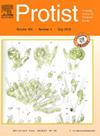Alexandrium minutum strains from a recombinant cross show correlated allelopathic activity against the diatom Chaetoceros muelleri and the parasite Amoebophrya sp., independent of PST toxicity.
IF 2.1
3区 生物学
Q4 MICROBIOLOGY
引用次数: 0
Abstract
Dinoflagellates of the genus Alexandrium can produce bioactive extracellular compounds (BECs) responsible for a wide range of effects on many organisms. These compounds are poorly characterized within the genus Alexandrium. The transmission of the allelopathic phenotype within the recombinant progeny in dinoflagellates has not been documented either. This study investigated the effects of these allelochemicals produced by two parental strains of the dinoflagellate Alexandrium minutum and their 14 recombinant progeny against two targets, the diatom Chaetoceros muelleri and the dinoflagellate parasite Amoebophrya sp.. Analyses by flow cytometry on proxy parameters of cell physiology revealed that the allelochemicals produced by 15 out of 16 strains appear to induce deleterious effects on the photosynthetic apparatus of C. muelleri as well as on cell size. The cell membranes of C. muelleri were also damaged by the filtrate of 9 strains. Finally, the allelochemicals of 8 A. minutum strains seem to have a deleterious effect on the cell membranes of Amoebophrya sp. dinospore. The deleterious effects against the two targets were correlated. However, they were not correlated with pH, cell size, or paralytic shellfish toxin content. Overall, our results suggest that 1) among the allelochemicals produced by A. minutum, some would have an effect on the same molecular targets in both Amoebophrya sp. and in C. muelleri, 2) specific metabolite production of each strain was responsible for the range of effects observed and 3) the heritability of allelochemical production in A. minutum may involve several genetic loci.
重组杂交的微小亚历山大菌菌株对硅藻毛囊毛藻和寄生虫变形虫具有相关的化感作用,与PST毒性无关。
亚历山大藻属的鞭毛藻可以产生生物活性的细胞外化合物(BECs),对许多生物产生广泛的影响。这些化合物在亚历山大属中特征不明显。化感表型在重组鞭毛藻后代中的传递也没有文献记载。本研究研究了两种鞭毛藻亚历山大菌(Alexandrium minutum)亲本菌株及其14个重组子代菌株对硅藻毛氏毛毛藻(Chaetoceros muelleri)和鞭毛藻阿米巴虫(Amoebophrya sp.)两种目标生物产生的化感物质的影响。流式细胞术分析了16个菌株中有15个菌株产生的化感物质对木孢的光合器官和细胞大小产生了有害的影响。9株菌株的滤液对穆勒梭菌的细胞膜也有破坏作用。最后,8株微小变形虫的化感化学物质似乎对变形虫的细胞膜有有害的影响。对这两个靶标的有害作用是相关的。然而,它们与pH值、细胞大小或麻痹性贝类毒素含量无关。综上所述,我们的研究结果表明:1)在黄麻产生的化感物质中,有一些会对阿米巴虫和黄麻中相同的分子靶点产生影响;2)每个菌株的特定代谢物产生的影响范围负责;3)黄麻产生化感物质的遗传力可能涉及多个遗传位点。
本文章由计算机程序翻译,如有差异,请以英文原文为准。
求助全文
约1分钟内获得全文
求助全文
来源期刊

Protist
生物-微生物学
CiteScore
3.60
自引率
4.00%
发文量
43
审稿时长
18.7 weeks
期刊介绍:
Protist is the international forum for reporting substantial and novel findings in any area of research on protists. The criteria for acceptance of manuscripts are scientific excellence, significance, and interest for a broad readership. Suitable subject areas include: molecular, cell and developmental biology, biochemistry, systematics and phylogeny, and ecology of protists. Both autotrophic and heterotrophic protists as well as parasites are covered. The journal publishes original papers, short historical perspectives and includes a news and views section.
 求助内容:
求助内容: 应助结果提醒方式:
应助结果提醒方式:


